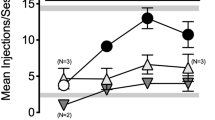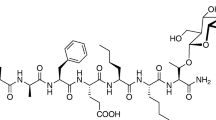Abstract
Rationale
Opioids remain the drugs of choice for treating moderate to severe pain, although adverse effects often limit use. Drugs acting concomitantly as agonists at μ opioid receptors and antagonists at δ opioid receptors produce antinociceptive effects with a reduced profile of adverse effects; one such drug, benzylideneoxymorphone (BOM), might further limit adverse effects because it appears to have lower pharmacological efficacy than other μ opioid receptor agonists.
Objectives
The current study compared the acute behavioral effects of BOM with the effects of other μ opioid receptor agonists.
Methods
Discriminative stimulus and rate-decreasing effects were studied in 1 group of 7 rats discriminating 3.2 mg/kg morphine while responding under a fixed-ratio 10 schedule of food presentation. Antinociceptive effects were determined in a second group of 8 rats using a warm water tail withdrawal procedure. Reinforcing effects were evaluated in a third group of 12 rats with a history of remifentanil self-administration.
Results
BOM produced morphine-lever responding and both discriminative stimulus and rate-decreasing effects were antagonized by naltrexone. BOM did not markedly increase tail-withdrawal latencies from water maintained at 50 °C and did not substantially attenuate the antinociceptive effects of morphine. BOM was not self-administered and did not change remifentanil self-administration.
Conclusions
Some effects of BOM (e.g., discriminative stimulus effects) appear to be mediated by μ opioid receptors; however, BOM is not self-administered by rats, suggesting that it might have limited abuse liability and a reduced profile of adverse effects compared with currently prescribed opioids.







Similar content being viewed by others
References
Abdelhamid EE, Sultana M, Portoghese PS, Takemori AE (1991) Selective blockade of delta opioid receptors prevents the development of morphine tolerance and dependence in mice. J Pharmacol Exp Ther 258:299–303
Ananthan S, Saini SK, Dersch CM, Xu H, McGlinchey N, Giuvelis D, Bilsky EJ, Rothman RB (2012) 14-Alkoxy- and 14-acyloxypyridomorphinans: mu agonist/delta antagonist opioid analgesics with diminished tolerance and dependence side effects. J Med Chem 55:8350–8363
Collins GT, Woods JH (2007) Drug and reinforcement history as determinants of the response-maintaining effects of quinpirole in the rat. J Pharmacol Exp Ther 323:599–605
Cunningham CW, Elballa WM, Vold SU (2019) Bifunctional opioid receptor ligands as novel analgesics. Neuropharmacology 151:195–207
Dowell D, Haegerich TM, Chou R (2019) No shortcuts to safer opioid prescribing. N Engl J Med 380:2285–2287
Dowell D, Haegerich TM, Chou R (2016) CDC guideline for prescribing opioids for chronic pain—United States, 2016. MMWR Recomm Rep 65:1–49
Gerak LR, Butelman ER, Woods JH, France CP (1994) Antinociceptive and respiratory effects of nalbuphine in rhesus monkeys. J Pharmacol Exp Ther 271:993–999
Gerak LR, France CP (2014) Discriminative stimulus effects of pregnanolone in rhesus monkeys. Psychopharmacology 231:181–190
Gerak LR, France CP (2016) Combined treatment with morphine and Δ9-tetrahydrocannabinol in rhesus monkeys: antinociceptive tolerance and withdrawal. J Pharmacol Exp Ther 357:357–366
Harland AA, Bender AM, Griggs NW, Gao C, Anand JP, Pogozheva ID, Traynor JR, Jutkiewicz EM, Mosberg HI (2016) Effects of N-substitutions on the tetrahydroquinoline (THQ) core of mixed-efficacy mu-opioid receptor (MOR)/delta-opioid receptor (DOR) ligands. J Med Chem 59:4985–4998
Healy JR, Bezawada P, Griggs NW, Devereaux AL, Matsumoto RR, Traynor JR, Coop A, Cunningham CW (2017) Benzylideneoxymorphone: a new lead for development of bifunctional mu/delta opioid receptor ligands. Bioorg Med Chem Lett 27:666–669
Healy JR, Bezawada P, Shim J, Jones JW, Kane MA, MacKerell AD Jr, Coop A, Matsumoto RR (2013) Synthesis, modeling, and pharmacological evaluation of UMB 425, a mixed mu agonist/delta antagonist opioid analgesic with reduced tolerance liabilities. ACS Chem Neurosci 4:1256–1266
Kest B, Lee CE, McLemore GL, Inturrisi CE (1996) An antisense oligodeoxynucleotide to the delta opioid receptor (DOR-1) inhibits morphine tolerance and acute dependence in mice. Brain Res Bull 39:185–188
Li JX, Shah AP, Patel SK, Rice KC, France CP (2013) Modification of the behavioral effects of morphine in rats by serotonin (5-HT)1A and 5-HT2A receptor agonists: antinociception, drug discrimination, and locomotor activity. Psychopharmacology 225:791–801
Maguire DR, France CP (2014) Impact of efficacy at the μ-opioid receptor on antinociceptive effects of combinations of mu-opioid receptor agonists and cannabinoid receptor agonists. J Pharmacol Exp Ther 351:383–389
Morgan D, Cook CD, Picker MJ (1999) Sensitivity to the discriminative stimulus and antinociceptive effects of μ opioids: role of strain of rat, stimulus intensity, and intrinsic efficacy at the μ opioid receptor. J Pharmacol Exp Ther 289:965–975
National Research Council (2011) Guide for the care and use of laboratory animals, 8th edn. National Academies Press, Washington
Panlilio LV, Schindler CW (2000) Self-administration of remifentanil, an ultra-short acting opioid, under continuous and progressive-ratio schedules of reinforcement in rats. Psychopharmacology 150:61–66
Peng X, Knapp BI, Bidlack JM, Neumeyer JL (2007) Pharmacological properties of bivalent ligands containing butorphan linked to nalbuphine, naltrexone, and naloxone at μ, δ, and κ opioid receptors. J Med Chem 50:2254–2258
Rankovic Z (2015) CNS drug design: balancing physicochemical properties for optimal brain exposure. J Med Chem 58:2584–2608
Smith MA, Gray JD (2001) Age-related differences in sensitivity to the antinociceptive effects of opioids in male rats. Influence of nociceptive intensity and intrinsic efficacy at the mu receptor. Psychopharmacology 156:445–453
Walker EA, Young AM (2002) Clocinnamox distinguishes opioid agonists according to relative efficacy in normal and morphine-treated rats trained to discriminate morphine. J Pharmacol Exp Ther 302:101–110
Walker EA, Richardson TM, Young AM (1996) In vivo apparent pA2 analysis in rats treated with either clocinnamox or morphine. Psychopharmacology 125:113–119
Weed PF, Gerak LR, France CP (2018) Ventilatory-depressant effects of opioids alone and in combination with cannabinoids in rhesus monkeys. Eur J Pharmacol 833:94–99
Young AM, Kapitsopoulos G, Makhay MM (1991) Tolerance to morphine-like stimulus effects of μ-opioid agonists. J Pharmacol Exp Ther 257:795–805
Young AM, Masaki MA, Geula C (1992) Discriminative stimulus effects of morphine: effects of training dose on agonist and antagonist effects of mu opioids. J Pharmacol Exp Ther 261:246–257
Zhu Y, King MA, Schuller AGP, Nitsche JF, Reidl M, Elde RP, Unterwald E, Pasternak GW, Pintar JE (1999) Retention of supraspinal delta-like analgesia and loss of morphine tolerance in δ opioid receptor knockout mice. Neuron 24:243–252
Funding
These studies were supported by Welch Foundation Grant AQ-0039 (CPF) and the Concordia University Wisconsin School of Pharmacy (CWC).
Author information
Authors and Affiliations
Corresponding author
Ethics declarations
Conflict of interest
The authors declare that they have no conflict of interest.
Additional information
Publisher’s note
Springer Nature remains neutral with regard to jurisdictional claims in published maps and institutional affiliations.
Rights and permissions
About this article
Cite this article
Mada, S., Gerak, L.R., Soyer, A. et al. Behavioral effects of benzylideneoxymorphone (BOM), a low efficacy µ opioid receptor agonist and a δ opioid receptor antagonist. Psychopharmacology 237, 3591–3602 (2020). https://doi.org/10.1007/s00213-020-05638-1
Received:
Accepted:
Published:
Issue Date:
DOI: https://doi.org/10.1007/s00213-020-05638-1




